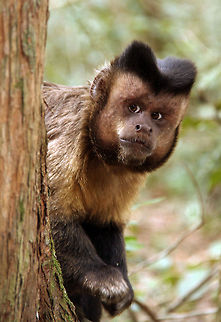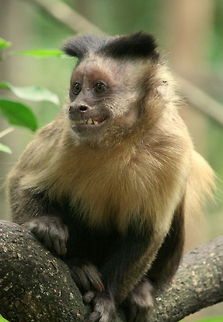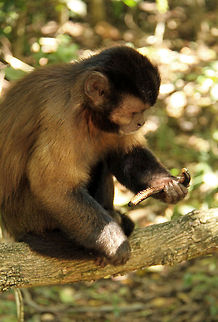
Appearance
The tufted capuchin is more powerfully built than the other capuchins, with rougher fur and a short, thick tail. It has a bundle of long, hardened hair on the forehead that can be raised as a sort of "wig". The fur is brownish gray, with the belly being somewhat lighter-colored than the rest of the body. The hands and feet are black. The tail is strong and can be used as a grasping tail.The tufted capuchin has a head-body length of 32 to 57 centimetres , a tail length of 38 to 56 centimetres , and a weight of 1.9 to 4.8 kilograms , with the males generally being larger and heavier than the females.

Distribution
This species lives in the northern Amazon rainforest of the Guyanas, Venezuela and Brazil and to the west of the Rio Negro, as far north as the Orinoco in Venezuela. It is also found in eastern Colombia, Ecuador, Peru, including the upper Andean Magdalena valley in Colombia. An introduced breeding population is well established in the northwestern peninsula of the island of Trinidad in the Republic of Trinidad and Tobago. It can be found in a large variety of forest types, mainly in tropical rainforests , but also in more open forests.The distribution overlaps with that of other species of capuchins, such as the White-fronted Capuchin .

Behavior
The tufted capuchin is a diurnal, arboreal primate species, but it often forages on the ground to search for food or to walk longer distances between trees that are too far apart to jump.The tufted capuchin lives in groups of two to twenty or more animals. A single group usually contains at least one adult male, but mixed groups with multiple males do also occur. In that case, one of the males is dominant. He accepts only a few monkeys in his direct surroundings, mainly younger animals and a few females. The dominant male and the group members that are close to him have the privilege to eat first in case of food scarcity, while subordinate monkeys have to wait until they are ready.
After a gestation period of 180 days, one young is born, or incidentally a twin. This young, which weighs only 200 to 250 grams, is carried on the back of its mother. The mother feeds her child for 9 months, but the young is sexually immature until its seventh year, which is quite late for a primate of its size.
Important natural enemies of the capuchin are large birds of prey. They are so afraid of those birds, that they even become alarmed when a harmless bird flies over.
The tufted capuchin rubs urine on its hands and feet in order to attract mates and reduce stress.The tufted capuchin has been observed using containers to hold water, using sticks , using sponges to absorb juice, using stones as hammer and chisel to penetrate a barrier and using stones as hammer and anvil to crack nuts. While some of these tasks are relatively simple by cognitive standards , others, like cracking nuts with hammer and anvil are only exceeded in complexity by chimpanzees.
The potential for tool use in animals like the Tufted Capuchin depends on a number of conditions that would increase its likelihood of appearing in a given species. Van Schaik proposed that the occurrence of tool use would be likely in foraging species if three factors were present: ''manual dexterity'', ''intelligence'', and ''social tolerance''. As it applies to manual dexterity, capuchins are capable of a limited precision grip , which is not found in any other New World monkeys and only found in limited amounts in apes. ''C. apella'' has an encephalization ratio greater than the hominids and a neocortex ratio that is almost as large as the apes; both of these rough indicators suggest high intelligence....hieroglyph snipped... Finally, the Tufted Capuchin forms social groups typical of a complex and tolerant society.
The tufted capuchin has been observed manufacturing tools both in captivity and in the wild. In captivity, it has been reported as making probing sticks to reach normally inaccessible containers with syrup. It is also capable of understanding the concept of "sponging" and using paper towels, monkey biscuits, sticks, leaves and straw to sop up juice and then suck on the sponge to consume the juice. Research in the wild has shown that capuchin tool use is every bit as extensive as in captivity with capuchins being observed using stones to dig holes to get at tubers, an activity previously only seen in humans. The practice of using stones to crack nuts has arisen spontaneously in many locations such as in the Caatinga Dry Forest and Serra da Capivara National Park, all in Brazil and hundreds of miles apart. It has been observed cracking various nuts and fruits such as palm nuts and ''jatobá'' fruits. The tufted capuchin has even been observed using stones to dislodge other stones that would later be used as hammers or shovels, an example of a more complex tool using behavior known as second-order tool use previously only found in chimpanzees. Curiously, not all tufted capuchins engage in tool use. Moura and Lee suggest lack of other food sources as the key factor. Ottoni and Mannu , Fragaszy ''et al''. and Visalberghi ''et al''. have proposed this is likely more a factor of a monkey's terrestrial habit: the more time a monkey spends on the ground, the more likely it is to profit from tool use.
In captivity, the tufted capuchin has been seen to manufacture stone tools that produced simple flakes and cores. Some of the capuchins even used these sharpened stones to cut barriers in order to reach food. The importance of this behavior is that it serves as evidence of ''mechanical proclivity to modify stones by using behaviors already in the monkeys' repertoires'', and this behavior is seen as a precursor to stone-knapping. This early and limited tool use behavior has been hypothesized as similar to pre-''Homo habilis'' and that artifacts of that time would probably resemble those of capuchins.
''C. apella'' tool manufacture and use has been analyzed for potential clues to social learning and problem solving ability, as tool manufacture and use can often shed light on such complex cognitive abilities. Social learning, or the ability to learn from other individuals, is a controversial topic in most nonhuman species like ''C. apella'' because of the relative difficulty of determining whether a behavior was learned from imitation or a much simpler form of social learning. One way of closing the gap between concurrent tool related behaviors and their likelihood of arising from imitation is by narrowing down events that would make social learning more probable such as a preference for observing experienced tool users. In this regard, Ottoni and his team found that young capuchins tended to observe the best tool users when cracking nuts. Another way of isolating imitation from other simpler behaviors is to present the capuchins with a box that has food but has two different ways of opening it. The important point is that neither way should be more advantageous so that the monkey can freely choose one. In one such study, when humans opened the door in front of the monkeys using one way only, the monkeys used that method, even when they discovered the alternative on their own. In another study, capuchin alphas from two separate groups were trained to open the door in a specific way, after which the monkeys were paired with subordinates who learned to open the door in the same way. When capuchins are trained in the same way and this time released into their groups, the habit is once again disseminated amongst all group members even when others discover alternative ways. Nevertheless, the subject of whether or not ''C. apella'' learns by imitation is still controversial, because of the inherent difficulty in teasing out unambiguous evidence of a complex cognitive process such as imitation.

Habitat
The tufted capuchin is a diurnal, arboreal primate species, but it often forages on the ground to search for food or to walk longer distances between trees that are too far apart to jump.The tufted capuchin lives in groups of two to twenty or more animals. A single group usually contains at least one adult male, but mixed groups with multiple males do also occur. In that case, one of the males is dominant. He accepts only a few monkeys in his direct surroundings, mainly younger animals and a few females. The dominant male and the group members that are close to him have the privilege to eat first in case of food scarcity, while subordinate monkeys have to wait until they are ready.
After a gestation period of 180 days, one young is born, or incidentally a twin. This young, which weighs only 200 to 250 grams, is carried on the back of its mother. The mother feeds her child for 9 months, but the young is sexually immature until its seventh year, which is quite late for a primate of its size.
Important natural enemies of the capuchin are large birds of prey. They are so afraid of those birds, that they even become alarmed when a harmless bird flies over.
The tufted capuchin rubs urine on its hands and feet in order to attract mates and reduce stress.This species lives in the northern Amazon rainforest of the Guyanas, Venezuela and Brazil and to the west of the Rio Negro, as far north as the Orinoco in Venezuela. It is also found in eastern Colombia, Ecuador, Peru, including the upper Andean Magdalena valley in Colombia. An introduced breeding population is well established in the northwestern peninsula of the island of Trinidad in the Republic of Trinidad and Tobago. It can be found in a large variety of forest types, mainly in tropical rainforests , but also in more open forests.
The distribution overlaps with that of other species of capuchins, such as the White-fronted Capuchin .

Food
A recently discovered characteristic of one population of this species is that it uses stones as a tool to open hard nuts. First it chooses ripe nuts from a nut palm. It uses its teeth to strip off the nut's fibrous husk. Then it leaves the nut to dry for about a week. When the nut is dry, the monkey lays the nut on a large, flat rock or fallen tree, hammering the nut with a suitable stone until the nut cracks. The hammer stones are often large enough to require lifting with both hands. The anvil rock is often pock-marked with hollows as a result of repeated use.Besides nuts, the capuchin also eats fruit, insects and larvae, eggs and young birds, frogs, lizards, and even bats. They are also known to chase cats.
The tufted capuchin looks for its food in groups. As soon as one of the group members has found something edible, he or she may make a large whistling sound, dependent upon the proximity of other individuals and abundance of the food resource, so that the other monkeys know that there is something to eat. The composition of the group is very well organized, and is determined by rank in the hierarchy. The dominant male often resides somewhere in the middle of the group just behind the front line, so that it is safer when a predator attacks. The vanguard is composed of higher-ranked females who are tolerated by the dominant male. They have the privilege to reach the food first, but they are also the most vulnerable when a predator attacks.
References:
Some text fragments are auto parsed from Wikipedia.